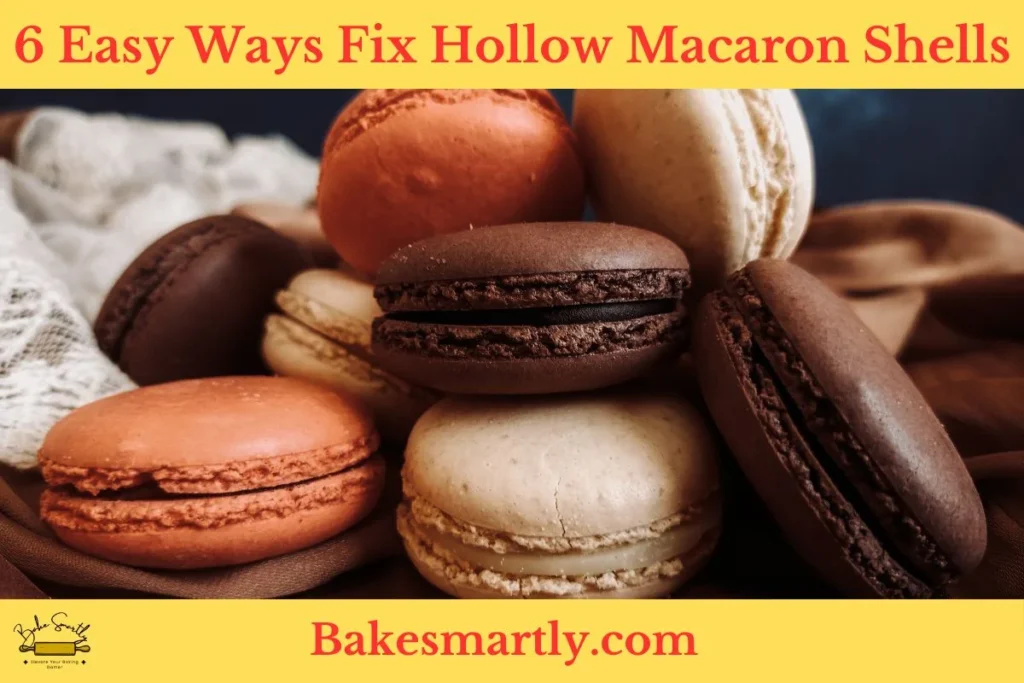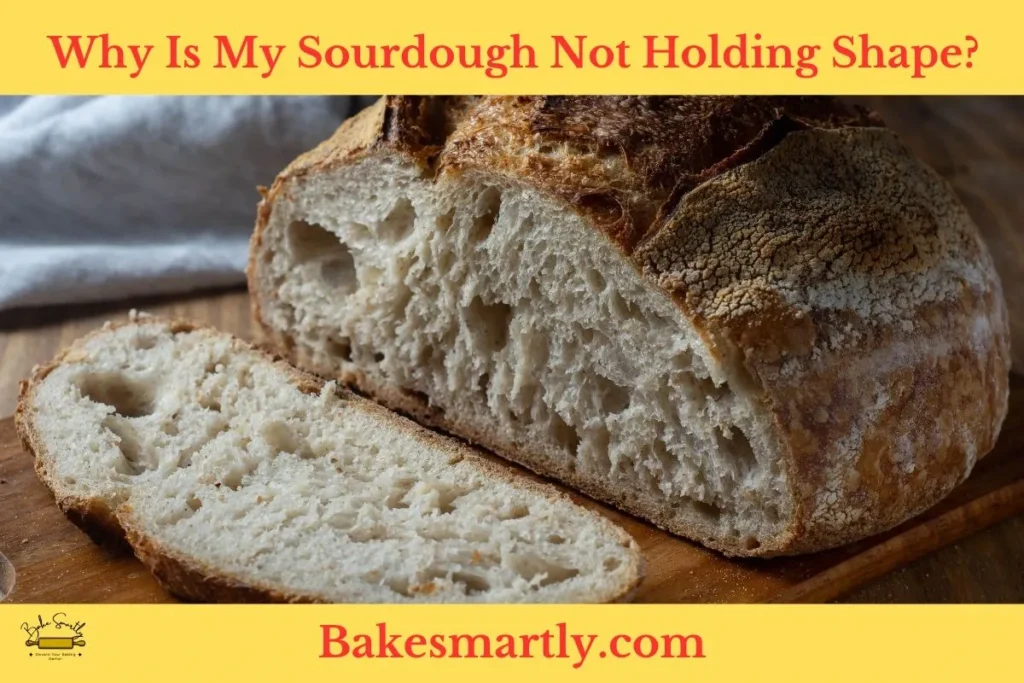
5 Easy Ways to Prevent Focaccia from Sticking to the Pan
Focaccia bread, with its delicious golden crust and delightful texture, is a favorite with bread lovers. Whether you’re a seasoned baker or a kitchen novice, you may have encountered the frustration of your focaccia sticking to the pan.
If you’ve ever dealt with this cooking headache, don’t worry! In this blog post, we’ll go over five easy and effective ways to stop your focaccia from sticking to the pan, so your baking efforts turn out perfectly every time.
Table of Contents
ToggleCommon Reasons Why Your Focaccia Is Sticking to the Pan
To make sure your focaccia comes out perfectly and doesn’t stick, it’s important to understand why it might be sticking. Here are five reasons why your focaccia is sticking to the pan.
Focaccia Dough Too Wet
If your focaccia dough is too wet, it’s likely to stick to the pan. While some moisture is good for a soft inside, too much water makes the crust sticky. Make sure your dough has the right amount of moisture by adding more flour gradually if it’s too wet.
Low-Quality or Wrong Pan
The type of pan you use makes a big difference. Cheap pans with rough surfaces or no non-stick coating can cause sticking. Use a good-quality, non-stick pan made for baking to get a smooth surface that won’t make your focaccia stick.
Also, using the wrong kind of pan, like a dark one that absorbs too much heat, can mess up your baking and make your focaccia stick.
Crowding the Pan
Trying to bake too many focaccias at once might seem like a time-saver, but it can mess up the baking process. When the dough is too close together, air can’t circulate properly, and heat isn’t evenly distributed.
This leads to uneven baking and sticking. Leave enough space between each piece of dough for even baking and to prevent them from sticking together.
Using the Wrong Flour
The flour you use affects how your focaccia turns out. Some flours have more protein, which can make the crust stickier. Choose a good bread flour or all-purpose flour with the right protein content to get the balance between structure and softness that you want.
Not Letting the Focaccia Cool
Trying to rush things after baking can also cause sticking. Let your focaccia cool in the pan for a few minutes before you try to take it out. This gives the crust time to set, so it’s less likely to stick.
If it’s still stuck, gently use a spatula or twist the pan a bit to loosen it without wrecking your bread.
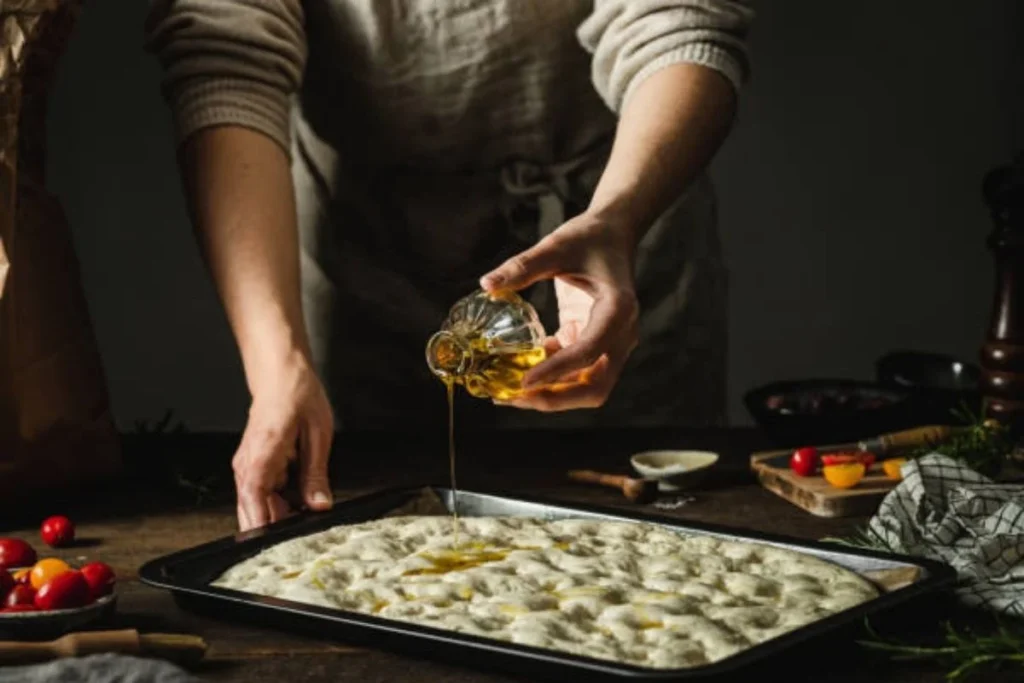
How to Prevent Focaccia from Sticking to the Pan in 5 Easy Methods
Preventing focaccia from sticking to the pan is crucial for achieving a perfectly baked and easily removable bread. Here are five easy methods to ensure your focaccia comes out of the pan effortlessly:
1. Grease the Pan Properly
One of the easiest ways to stop your focaccia from sticking to the pan is to grease it up well. The type of grease you use can affect how your bread tastes and feels. Lots of folks go for olive oil because it adds a rich flavor that goes great with focaccia.
To grease the pan, just spread a thin layer of olive oil all over it. You can use a brush or your fingers to cover every bit, including the sides.
This helps keep the dough from getting stuck and makes it easy to get the bread out when it’s done baking. Just remember not to go overboard with the oil – too much can make your focaccia greasy, so go easy on it.
For an extra kick of flavor, think about infusing your olive oil with herbs and garlic. Heat the oil with your favorite herbs and minced garlic, let it cool down, and then strain out the solid bits. This infused oil not only stops the dough from sticking but also gives your focaccia a fantastic smell and taste.
2. Parchment Paper
If you want a surefire way to keep your focaccia from sticking, parchment paper is the trick. It makes sure your bread slides right out of the pan and makes cleanup a breeze.
Start by lightly greasing the pan. Then, lay a sheet of parchment paper inside the pan, leaving some hanging over the edges. This makes it easy to lift the focaccia out once it’s baked.
Press the parchment paper down into the greased pan to make sure it sticks. After that, give the parchment paper itself a light greasing before you add the focaccia dough. This combo of a greased pan and parchment paper gives you double protection against sticking.
3. Use a Good Pan
Having a quality pan with a non-stick coating can help keep your focaccia from sticking. Non-stick pans, usually made of materials like aluminum or silicone, have a smooth surface that makes it hard for the dough to stick.
But before you use a non-stick pan, be sure to follow the manufacturer’s instructions for seasoning or conditioning it. This keeps the non-stick coating working well over time. Avoid using metal utensils that could scratch the coating and mess up its non-stick powers.
Keeping your non-stick pans clean is also important. Wash them soon after using them, using gentle soap and soft sponges to avoid scratching the coating. By taking care of your pan and using it right, you’ll make it easy for your focaccia to come out perfectly.
4. Dust with Cornmeal or Flour
An old-school way to keep things from sticking is to dust the pan with flour or cornmeal. It not only adds a nice rustic touch to your focaccia but also puts a barrier between the dough and the pan.
After greasing the pan lightly, sprinkle a bit of flour or cornmeal evenly over the greased surface. Tilt and tap the pan to spread it out, making sure everything’s covered. This step stops the dough from sticking and gives your crust a great look and feel.
Try using different kinds of flour, like semolina or whole wheat, to give your focaccia some unique flavors and textures. And don’t forget to shake off any extra flour or cornmeal to keep your crust from getting too powdery.
5. “Bake in” Your Pan First
Here’s a neat trick to make your pan non-stick: bake something in it before you use it for focaccia. This helps create a natural non-stick layer and makes sure your bread comes out of the pan easily.
Start by greasing the pan lightly, then stick it in the oven while it’s preheating. Let it heat up for about 10-15 minutes. This opens up the pores in the pan and gives it a seasoned surface.
After it’s heated up, take the pan out of the oven and let it cool down. Once it’s cooled off, wipe away any extra oil with a paper towel. Now your pan is seasoned and all set for baking your perfect focaccia.
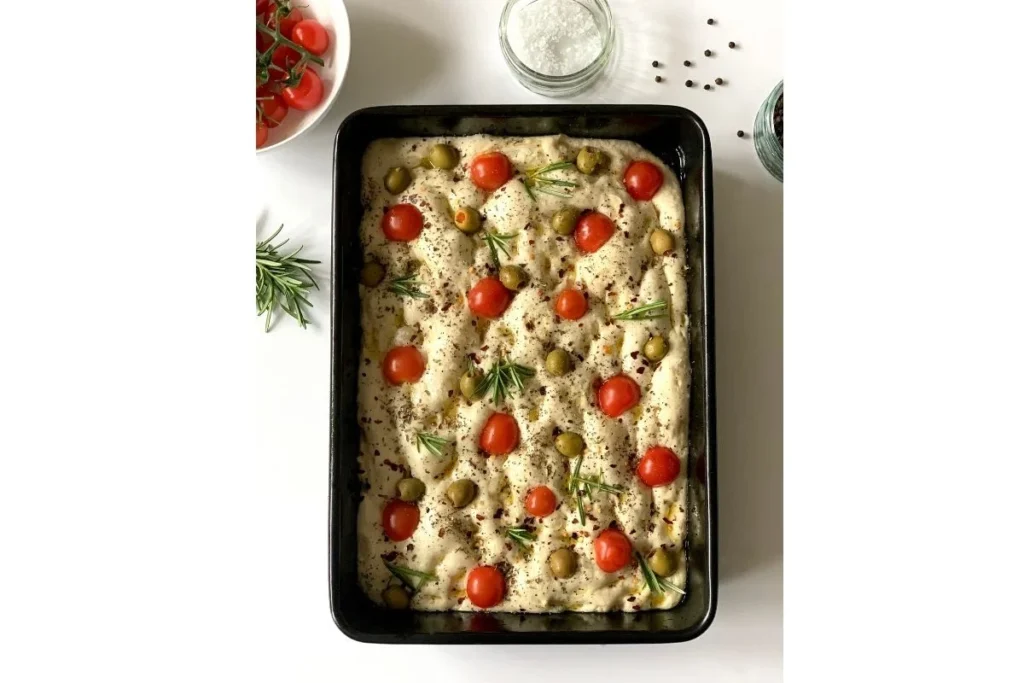
How to Remove Focaccia From the Pan | A Stress-Free Guide
So, you’ve poured your heart and soul into baking that perfect focaccia, and the last thing you want is for it to stick stubbornly to the pan. But don’t worry! Getting your focaccia out of the pan can be a piece of cake with the right techniques.
Here’s an easy guide to help you through the delicate task of freeing your golden-brown masterpiece:
1. Let It Cool: Give your focaccia some time to cool down in the pan before trying to take it out. A hot loaf is delicate and more likely to break, but a properly cooled one is sturdier and less likely to stick. Wait at least 15-20 minutes for it to set and firm up.
2. Loosen the Edges: Once your focaccia has cooled, use a thin, flexible knife to gently go around the edges of the pan. This helps loosen any crust that might be stuck. Just be careful not to dig too deep and mess up the pan or the bread.
3. Use Parchment Paper: If you’ve lined your pan with parchment paper, those overhanging edges are like built-in handles. Just grab the parchment paper and lift the focaccia out; it should come off the pan easily. This not only prevents sticking but also makes for a clean removal.
4 Flip It: For pans without parchment paper, carefully flip the pan onto a clean surface like a cutting board or wire rack. Give it a little shake or tap to coax the focaccia out. The cooling down and gravity should do the trick, letting the bread separate from the pan smoothly.
5. Give It a Tap: If your focaccia is still stuck, despite your best efforts, try tapping the bottom of the pan with a wooden spoon or your knuckles. This rhythmic tapping can help loosen the bread without causing any harm. Keep tapping and turning the pan until you feel the focaccia letting go.
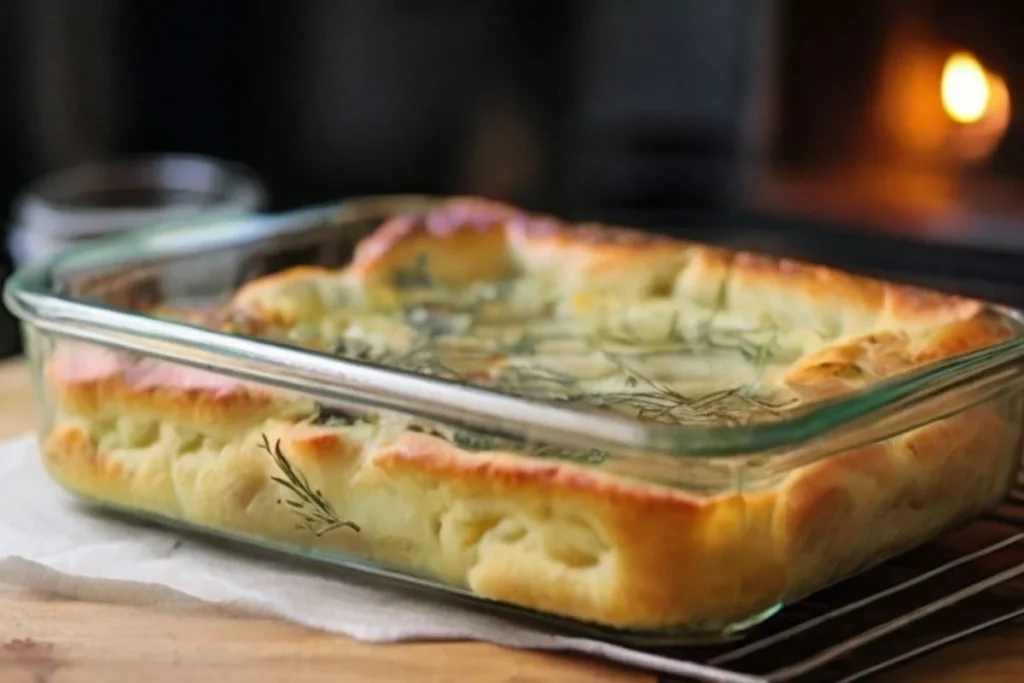
Can I Bake Focaccia in a Glass Pan?
Yes, you can bake focaccia in a glass pan. Baking in a glass pan offers certain advantages and considerations, making it a viable alternative to other materials like metal or ceramic.
Here are some points to keep in mind when using a glass pan for baking focaccia:
Even Heating: Glass pans distribute heat evenly, promoting consistent baking throughout your focaccia. This even heat distribution helps achieve a uniform texture and a golden-brown crust.
Monitoring the Bottom: The transparency of glass allows you to monitor the browning of the bottom crust more easily. Keep an eye on the color to ensure that the focaccia is baking evenly and doesn’t become overly browned.
Greasing and Lining: Despite its non-stick properties, it’s still advisable to grease a glass pan before placing the focaccia dough. You can use butter, oil, or cooking spray for this purpose. Additionally, if you want an extra layer of protection against sticking, consider using parchment paper in the glass pan.
Adjusting Temperature: Glass pans may retain heat more effectively than some other materials. As a result, you might want to reduce the oven temperature by 25°F (about 14°C) compared to what the recipe suggests when using a metal pan. This adjustment helps prevent the bottom of the focaccia from becoming too dark or crispy.
Careful Handling: Glass pans are generally more fragile than metal pans, so it’s essential to handle them with care. Avoid sudden temperature changes, such as placing a hot glass pan on a cold surface, as this can lead to cracking. Allow the glass pan to cool gradually.
Preheating: Preheating the glass pan along with the oven can enhance its ability to evenly distribute heat. Place the glass pan in the preheated oven before adding the focaccia dough.
Cleaning: Glass pans are relatively easy to clean, but be cautious when using metal utensils to cut or remove the focaccia to avoid scratching the glass surface. Opt for softer utensils like silicone or wooden tools.
Bonus Tip: Also, keep an eye on the focaccia during baking, as glass pans may lead to slightly longer baking times. Use a toothpick or cake tester to check for doneness – insert it into the center of the focaccia, and if it comes out clean or with a few moist crumbs (not wet batter), the focaccia is ready.
Frequently Asked Questions (FAQS)
How do you make focaccia not stick to the pan?
To prevent focaccia from sticking to the pan, generously grease the pan with olive oil or cooking spray. This creates a non-stick surface and imparts a delicious flavor to the crust.
What to do if focaccia dough is too sticky?
If your focaccia dough is too sticky, gradually add more flour until it reaches a soft and manageable consistency. Avoid adding too much flour at once to maintain the desired texture.
Should I use baking paper for focaccia?
While it’s not mandatory, using baking paper for focaccia can make removal easier and help prevent sticking. Simply place a sheet on the pan, then spread and bake the dough as usual for a convenient and fuss-free process
Final Thoughts
With these five simple and practical tips, you’ll be able to stop focaccia from sticking to the pan and make bakery-quality focaccia in your own kitchen.
From picking the right pan to getting the hang of greasing and flouring, each step is important to make sure your focaccia turns out great without sticking. Try out these methods, and before you know it, you’ll be dishing out delicious, golden-brown focaccia that’ll wow your loved ones. Happy baking!
Lindsey Mackenzie
About me
Hi there! I’m Lindsey Mackenzie, the founder of Bake Smartly. Baking has been my passion since childhood, growing up in my father’s bakery. With Bake Smartly, I’m excited to share my love for all things sweet and savory. Join me on this delicious journey as we whip up scrumptious treats and sprinkle joy into every bite!

